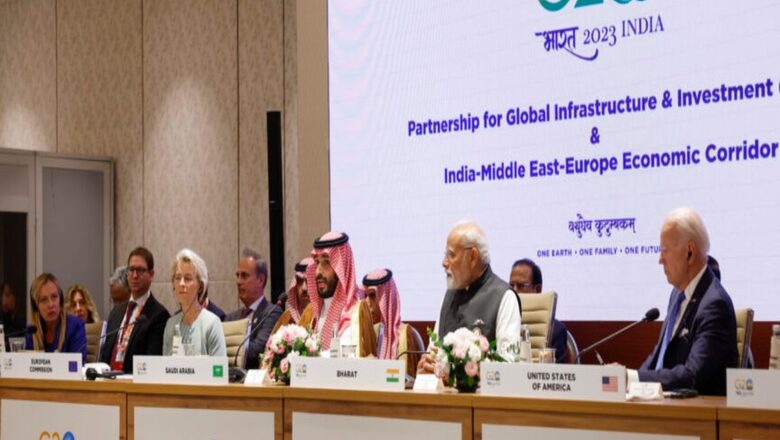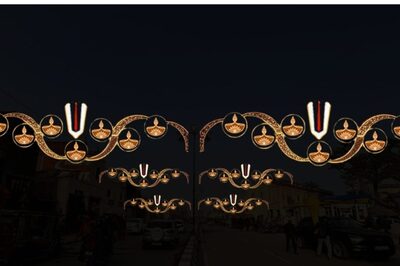
views
The initiation of the India-Middle East-Europe Economic Corridor (IMEC) project during the recently concluded New Delhi G20 Summit (9-10 September 2023) demonstrates the importance of connectivity projects and the significance of global cooperation in the areas of climate change, food security, digitalisation, and sustainable security. The IMEC corridor will also substantially challenge China’s hegemonic One Belt One Road (OBOR) project. At the same time, the Corridor will mark a new phase in West Asian geopolitics. The IMEC also revitalises India’s historic trade connectivity with West Asia and the Mediterranean Region. In a nutshell, it can be stated that IMEC is emerging as the emerging “geopolitical pivot” in the global order.
Introduction
Global geopolitics has undergone a tectonic shift in recent years, and one aspect which adds a pulse to it is the transnational connectivity projects. These transnational connectivity projects bring goods and people together, thus adding substance to the dynamics of international relations. As has been argued by liberal scholars of the Discipline of International Relations, trade and connectivity are the quintessence of “perpetual peace”, to paraphrase German philosopher Immanuel Kant. In more recent years, the ‘Democratic Peace Theory’ underlined by Michael Doyal talks about the significance of trade in ushering in a democratic world order. Most classical geopolitical theories underline expanding trade routes, thus getting a privileged position in global politics.
The New Delhi Declaration of the G20 can be considered a game changer in the form of providing alternative paradigms to international relations, in the form of creating equitable, inclusive and sustainable order, enhancing cooperation in renewable energy like the enunciation of International Hydrogen Alliance, climate financing and enhancing a framework of cooperative geopolitics in the global arena. Some of these issues are discussed at length in the recently concluded G20 Summit under India’s Presidency.
Along with some of the issues discussed in the G20 Summit, another issue which got added importance during the Summit is the launching of the India-Middle East-Europe Economic Corridor on September 9. Launching the IMEC can be considered a new phase regarding the global geopolitical connectivity project. In this context, there is a need to understand the geopolitical dimensions of the project.
The significance of the IMEC can be understood from the fact that it is a multi-modal transport connectivity (land, sea and rail) corridor connecting the emerging market of India with the energy-rich Middle East and the European market. Along with India, the other countries who have attended the inauguration of the IMEC connectivity projects are the US, Germany, France, Italy, Mauritius, UAE and Saudi Arabia, besides the EU as a regional body.
From the member countries of the project as well as the route it will traverse, one can underline that this route has immense significance in the context of present geopolitical realities. In this regard, it is pertinent to examine the importance of the connectivity project in a broader geopolitical milieu, which operates both in the regional and global geopolitical context.
The Geopolitical Context of IMEC
The IMEC can be studied in the geopolitical context. These are:
- Growing apprehension of China-led OBOR in the West Asian region and Europe over the years.
- The operationalisation of IMEC will herald a new geopolitical realignment in global politics.
- This IMEC connectivity project will contribute to trade and digital connectivity and foster economic growth.
To understand the significance of the IMEC project, it is necessary to understand the above-mentioned geopolitical dimensions in great detail.
Initially, the OBOR project received much attention from European countries, particularly from Central and Eastern Europe under economic transition along with Italy and Portugal, etc. However, these countries’ membership in OBOR has also created much jitter within the European Union. This sends a clear signal to three major countries of the EU, France, Germany and Great Britain (before Brexit), about the threat posed by China. Over the years, the European countries have also been wary of China’s industries, which substantially challenge the EU industries, particularly the manufacturing sector. In this context, the EU countries launched their ambitious project known as Global Gateway in 2021 as an alternative to the OBOR Project. The primary objective of this Project is to boost both the infrastructure and digital connectivity of Europe with the Global South countries.
Similarly, many EU countries, particularly Central and East Europe, are expressing their apprehensions over China’s ambitious imperial objectives. In this regard, it is pertinent to highlight that the EU countries have expressed grave concern over the years about the OBOR project. This forced the Baltic countries Lithuania, followed by Estonia and Latvia, to abandon China. Even other member countries of the above grouping are considering leaving this China-led arrangement. One may recall here that the EU also imposed heavy duties on imported products from China to protect its own industries. Even the EU has expressed its apprehensions about the OBOR project several times.
In this regard, it is pertinent to underline that Italy, considered a partner of China and occupies a significant position in the European continent, has also expressed its intention to leave the OBOR Project. Italian Prime Minister Giorgia Meloni disclosed the same at the sideline of the recent New Delhi G20 Summit. This means it is a strong setback to China’s European geoeconomic diplomacy. The apprehensions of the European countries increased after the onset of the Russia-Ukraine war and the subsequent spillover effect on the European countries. The EU countries and China have mutual apprehensiveness towards each other, which can be rooted in history. In this context, there is a growing clamour within the EU to isolate China.
Although Saudia Arabia and UAE are part of the Chinese-led OBOR, these countries seek to diversify their strategic relations. Both countries are known for their extensive energy production, but fossil fuel’s gradual decline in the international market has forced them to rethink their energy strategy. In this context, Riyadh and Abu Dhabi are keen to diversify their energy market and tap new markets. Hence, India and Europe can also be lucrative markets for both the West Asian countries. Understanding the negative fallout of the oil economy and the future glut of the energy market, both countries are keen to diversify their energy relations. Saudi Arabia and UAE have also buried their past apprehensions and are working towards making them a strategic hub of the Middle East and North Africa Region (MENA). Similarly, both countries are looking towards India for technological assistance in the solar sector. The Saudi Vision 2030 Document has also called for energy sector diversification.
At the same time, Riyadh and Abu Dhabi are keen to explore their strategic advantage of being located at the “centre” of global geopolitics because of their location as the core of “Rimland”, as stated by Nicolas J Spykman. Besides this, the Saudis and the UAE are keen to export electricity and hydrocarbon energy to Europe. In the aftermath of the Russia-Ukraine war, European countries are eager to tap the energy resources through the Mediterranean Sea. The growing cooperation between Saudi Arabia and Greece can also be seen in this context. Saudi Arabia is keen to take the locational advantage of Greece and wants to use Athens as a strategic hub for exporting energy to Europe. A common strategic outlook in the form of opposition to the imperial Ottoman legacy of Turkey is also binding the relationship between the two countries. At the same time, the UAE is also strengthening infrastructural linkages with Israel in the form of railway connectivity, which, as reported, passes through Jordan and Saudi Arabia, and will be considered a game changer for the connectivity project in this part of the world. It is a fact that the Mediterranean Sea can play a pivotal role in connecting with Europe.
Over the years, Israel has emerged as a major hub for transport as well as the export of energy to the European market. In the first week of September 2023, Israel, Greece and Cyprus agreed to augment their trilateral energy cooperation, ultimately benefiting Europe in the long run. Thus, the Eastern Mediterranean region can be considered as the lynchpin in the context of energy supply to Europe. Therefore, Israel can be a major player in the European market. The trilateral joint declaration stated, “We agreed that the energy sector, particularly natural gas, electricity and renewable energy, is a solid foundation for regional cooperation”. All these developments demonstrate that connectivity, infrastructural development, and geoeconomic dimension play an essential role in geo-strategic development. Some of these strategic developments will isolate China in the Middle East geopolitics in the long run. No doubt China has brokered a peace deal between Iran and Saudi Arabia, but it is too early to predict the future of the peace agreement, looking at their historical rivalry. Saudi Arabia and UAE are trying to neutralise China’s role in West Asia as this may circumvent their external relations and annoy their long-standing strategic partner, the USA.
India, on the other hand, is giving geoeconomic connectivity a priority area of its foreign policy. Over the years, a number of connectivity projects have been initiated, like the INSTC, Chahbahar Connectivity Project, and Chennai-Vladivostok Maritime. Connectivity project, India-Myanmar -Thailand Project, etc., to name a few. India is also part of the Ashgabat Agreement. In this regard, it is pertinent to mention that in various multilateral bodies over the years, India has underlined the importance of the geo-economic connectivity project, which aims to bring out substantial economic development and facilitate greater geo-economic cooperation. India has also launched the SAGAR (Security And Growth For All In The Region) in the Indian Ocean region.
Underlining the importance of the SAGAR doctrine in envisaging India’s geopolitical connectivity in the Indian Ocean, Prime Minister Narendra Modi, at his keynote address at Shangari La Dialogue, stated, “Our interests in the region are vast, and our engagement is deep. In the Indian Ocean region, our relationships are becoming stronger”, and he further articulated that “we also work with partners beyond the Indian Ocean Region to ensure that the global transit routes remain peaceful and free for all”. In 2019, along with the Act East policy, India also envisaged the Act Far East Policy, which gives India an upper hand in Arctic geopolitics. At the same time, India is making inroads into the Black Sea by strengthening relations with Georgia and Armenia, which can be connected through Iran. This gives India a firm foothold on the Black Sea Coast. Along with this, the Indo-Pacific strategic corridor is emerging as the critical strategic arch of the global connectivity project. In this regard, India’s voyage into greater connectivity with the global community is commensurate with its growing geopolitical prowess. The same can be reflected in India’s stronger links with Greece, Israel, Cyprus, UAE, Jordan, Saudi Arabia and the EU as a regional block. It is necessary to highlight here that being a major Indo-Pacific player gives India an opportunity to navigate in the Mediterranean region. This also gives India a twin advantage, strengthening strategic partnerships with the countries of the region and augmenting bilateral economic cooperation.
As far as India and EU trade relations are concerned, bilateral trade is around €88 billion in 2021, per a European Commission report. As studies suggest, India’s third-largest trading partner is the EU. Besides the EU, India’s bilateral relations with France, Germany, and Italy are also growing at a faster pace. Similarly, India’s trade relations with Israel, UAE and Saudi Arabia are growing faster. As per the Ministry of External Affairs, Government of India Report, UAE is India’s “third-largest trading partner”, and the bilateral trade stood at $84.84 billion. Similarly, India’s trade with Saudi Arabia is also growing and is now a major trading partner of India. A large chunk of oil is imported from Saudi Arabia to India. At the same time, with Israel, there have been stronger both strategic and economic relations. Till 2022-23, the bilateral trade stood at $10.1 billion. One can infer from the above discussion that bilateral trade and political relationships have been strengthening with these countries over the years. Thus, it can be underlined that augmenting connectivity between West Asian countries, EU member countries and India can further the geoeconomic linkages and strengthen trade cooperation.
Some of India’s geoeconomic connectivity projects aim at harnessing the cooperative economic development process rooted in India’s philosophy of “Vasudhaiva Kutumbakam”. In this regard, there is a need to underline that the growing geo-economic stature of India is commensurate with its status as a global power. The same can also be reflected in India’s growing geopolitical engagement with Europe and West Asian countries along with the Mediterranean countries in recent years.
There is also a need to examine some of the historical writings to examine the importance of the IMEC project. The prophetic work of British geopolitical thinker Halford J Mackinder, who, in his book Geopolitical Ideals and Reality, highlighted the significance of the Black and Mediterranean Sea as the “heartland” in Eurasian geopolitics and strategised the need to control the above sea routes by the British government to gain greater preponderance. Similarly, K.M. Panikkar, in his classic work India and the Indian Ocean, highlights the significance of the Indian Ocean as a major connecting point. Panikkar, in his book, highlights the “millennium” old civilisational and commercial connection between “India and the Levant” (Eastern Mediterranean region) through the “Indian Ocean” (p.23). In this book, he further mentions the significance of the “Matra Yantra” for navigation purposes, which gave Indians an upper hand in the Indian Ocean. Panikkar also talks about the Indians’ “voyage to the Red Sea” (Ibid). It is pertinent to highlight that the Indian Ocean allowed India to navigate its diplomacy in faraway places like the Red Sea and the Mediterranean Sea, as one can infer from the above-mentioned historical trajectories. It has been further observed that the historical cultural contacts and trade, as well as the Indian Ocean, played a critical role in shaping India’s relations with the Mediterranean and the Arab World.
As discussed succinctly by Himanshu Prabha Ray in her article “Seafaring and Maritime Contacts: An Agenda for Historical Analysis”, published in 1996 in the Journal of the Economic and Social History of the Orient. Ray mentions that both in Ancient Indian texts as well as in the ancient Greek and Roman texts, these aspects were succinctly highlighted. As highlighted by Ray in the above article, spices like “black pepper and cardamom” used to be the dominant commodities exported to the Roman Empire from India through the Red Sea and the Mediterranean Sea. In this regard, it should be underlined here that Greek historians like Herodotus and Pliny succinctly dealt with these aspects in their historical accounts, as described by Grant Parker in his article titled, “Ex Oriente Luxuria: Indian Commodities and Roman Experience.” in Journal of the Economic and Social History of the Orient, published in 2002.
Some of these historical accounts must be contextualised in the present geopolitical analysis. As has been argued, the development of connectivity and the fruition of greater strategic cooperation between India and these West Asia and European countries can contribute substantially towards ushering in a new geopolitical order in a broader context. The significance of the IMEC connectivity project can be understood in this context.
Geopolitical Postulates of IMEC
While locating the IMEC project, three geopolitical postulates need to be studied. These are:
- Geo-strategic connectivity through land and sea corridor.
- A common economic imperative rooted in growth and development for IMEC countries.
- Need to counter China’s OBOR project, which is posing a more substantial challenge to the geo-economic and geo-political interests of these countries.
- Evolve an alternative comprehensive regional security paradigm in the evolving IMEC region.
These four above-mentioned geopolitical trajectories are shaping the dynamics of IMEC. In this regard, it can be noted that the success of IMEC is primarily determined by the movements of goods and commodities and by fostering greater connectivity, which can enhance trade and regional cooperation. As discussed above, some of the above-mentioned infrastructural projects can contribute to the fruition of trade and economic cooperation.
Michaël Tanchum, in a research monograph published in 2021 titled “India’s Arab-Mediterranean Corridor: A Paradigm Shift in Strategic Connectivity to Europe”, highlights that “Whether India becomes a global leader in forging this 21st-century commercial architecture depends on New Delhi’s ability to develop manufacturing value chains in the India-to-Europe Arab-Med Corridor” (p.4).
It may be recalled here that India is developing a multi-faceted trade relationship with the UAE and Saudi Arabia, which includes cooperation in the green energy food sector and cooperation in fossil fuel. In this regard, it can be underlined that the UAE and Saudi Arabia have sought closer cooperation with India in harnessing Solar energy in recent years. Similarly, the Indian business conglomerate Adani group acquired the Haifa port on the Mediterranean Coast, crisscrossing Asia and Europe by paying a whopping $1.2 billion. Haifa Port in future can play a significant role in boosting trade and economic cooperation between India, Israel and European countries. It is pertinent to highlight here that Indian conglomerate Adani Group acquired this port by outbidding Chinese and Turkish firms, as reported. Soon after handing the port to Adani Group, Israel Prime Minister Benjamin Netanyahu stated the port was “momentum”. He added, “Haifa will become the entry point and exit point for a vast number of goods that will reach the Mediterranean and Europe directly, without having to go around the Arabian peninsula”.
One can infer from Prime Minister Netanyahu’s above observation that he is keen to enlist India as a significant power in this part of the world. This can benefit Israel in many ways, like furthering strategic partnership with India and getting Foreign Direct Investment. At the same time, Israel is keen to become a major Mediterranean player. Cooperation with India will undoubtedly enhance Israel’s geo-political positioning in this part of the world.
The IMEC connectivity project got further impetus during the IU2U Virtual Summit in July 2022. In this Virtual Summit Meeting, India’s Prime Minister Narendra Modi, US President Joe Biden, Israel’s Prime Minister Yair Lapid, and UAE Sheikh Mohamed bin Zayed Al Nahyan. The Joint Declaration focused on two key areas of cooperation, which include “Food Security” and “Clean Energy”. The Meeting has established long-term cooperation in “ long-term strategic partnership to promote initiatives and investments that improve the movement of people and goods across hemispheres, and increase sustainability and resilience through collaborative science and technology partnerships”.
In May 2023, India’s National Security Advisor Ajit Doval, US Secretary of State Jake Sullivan, Saudi Prime Minister Mohammed bin Salman and UAE National Security Advisor Sheikh Tahnoon bin Zayed Al Nahyan met in Riyadh and gave a more significant push to the idea of connectivity between India and Middle East so also with Europe. The United States has also expressed keen interest in promoting the project as it will further its strategic goals in the complex geopolitics of the Middle East. Similarly, the strategic connectivity between India and the West Asian region will also help India to strengthen its geopolitical and more effective geoeconomic engagement with this region and the Mediterranean through Israel.
One factor that unites India, UAE, Saudi Arabia, Israel, and the US is to counter China and its OBOR project. This China-led project over the years has caused much anxiety and distress to different countries where this project is in operation. Similarly, by this strategic move of India, the US, UAE, Saudi Arabia, and Israel, China got a severe jolt to its dream of dominating West Asia, especially after it brokered a peace deal between Iran and Saudi Arabia. Similarly, as discussed above, European countries are shifting their focus to West Asian countries to ensure a perennial energy supply. Also, France and Germany, the two key European countries, are keen to strengthen their trade and strategic relations with India. For instance, France has recently been a critical supplier of defence equipment to India. India’s relations with Germany and Italy, the two key players in the IMEC project, are also improving at a faster pace.
It may be underlined here that the visit by Prime Minister Modi to Egypt in June 2023 further pushed India’s presence in the Mediterranean Region. As has been observed, the Mediterranean Region will soon be the lynchpin in the strategic arteries of global politics, though Egypt is not part of the IMEC project. In this context, some of the strategic moves will augment India’s presence in the region.
The IMEC project got an institutional shape at the sideline of the G20 Summit. The IMEC project, as underlined, has two corridor projects. The first one is the “Eastern Corridor connecting India to the Gulf Region” and the second is the “Northern Corridor connecting the Gulf region to Europe”. It has been further observed that “it will include a railway and ship-rail transit network and road transport routes”. Highlighting the significance of the IMEC Project and espousing India’s position, Prime Minister Modi stated, “We believe that connectivity is a source of increasing not only mutual trade but also mutual trust between different countries”. The Memorandum of Understanding of IMEC, which was signed during the G20 Summit, underlined that the “participants intend that the corridor will increase efficiencies, reduce costs, enhance economic unity, generate jobs, and lower greenhouse gas emissions — resulting in a transformative integration of Asia, Europe and the Middle East”. Expressing the significance of the project, US President Joe Biden stated, “This project is about more than just laying tracks. This is a game-changing regional investment.”
From the above discussions, it can be underlined here that the emergence of IMEC is going to alter the geopolitics of the West Asian region substantially. It will also facilitate greater connectivity between India and Europe through West Asia and the Mediterranean Region. What can be stated is that this Corridor is emerging as a major “geopolitical pivot” to paraphrase Mackinder in the 21st century.
Conclusion
The success of the IMEC Corridor will contribute substantially to the churning of a new kind of geopolitics. Further, this project significantly challenges China’s OBOR Project and provides an alternative to the West Asian and European countries regarding connectivity. At the same time, growing cooperation between Israel, Saudi Arabia and UAE will contribute to greater peace in West Asia and the Mediterranean Region. Similarly, cooperation in food security, climate change, and digitalisation is the first step towards evolving a sustainable security paradigm. This Corridor will give India an upper hand to revitalize its historic trade route with the West Asian and Mediterranean regions.
The author teaches at the School of International Studies, JNU, New Delhi. Views expressed in the above piece are personal and solely that of the author. They do not necessarily reflect News18’s views.




















Comments
0 comment